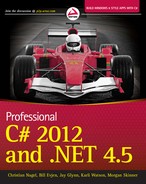CONTENTS
The Relationship of C# to .NET
A Closer Look at Intermediate Language
Creating .NET Applications Using C#
The Role of C# in the .NET Enterprise Architecture
The C# Preprocessor Directives
Multiple Objects of the Same and Different Types
Chapter 7: Operators and Casts
Comparing Objects for Equality
Chapter 8: Delegates, Lambdas, and Events
Chapter 9: Strings and Regular Expressions
Collection Interfaces and Types
Chapter 11: Language Integrated Query
Chapter 12: Dynamic Language Extensions
DynamicObject and ExpandoObject
Chapter 13: Asynchronous Programming
Why Asynchronous Programming Is Important
Foundation of Asynchronous Programming
Chapter 14: Memory Management and Pointers
Memory Management Under the Hood
Manipulating and Inspecting Code at Runtime
Chapter 16: Errors and Exceptions
User-Defined Exception Classes
Chapter 17: Visual Studio 2012
Working with Visual Studio 2012
Exploring and Coding a Project
Deployment as Part of the Application Life Cycle
Sharing Assemblies Between Different Technologies
Chapter 21: Tasks, Threads, and Synchronization
Authentication and Authorization
Distributing Code Using Certificates
Using a COM Component from a .NET Client
Using a .NET Component from a COM Client
Chapter 24: Manipulating Files and The Registry
Moving, Copying, and Deleting Files
Reading and Writing to the Registry
Reading and Writing to Isolated Storage
WebRequest and WebResponse Classes
Displaying Output As an HTML Page
Creating a Windows Service Program
Monitoring and Controlling Windows Services
Troubleshooting and Event Logging
Namespace System.Globalization
Windows Forms Localization Using Visual Studio
Localization with ASP.NET Web Forms
Localization with Windows Store Apps
Chapter 30: Managed Extensibility Framework
Containers and Export Providers
The Life Cycle of Applications
Fast Data Access: The Data Reader
Asynchronous Data Access: Using Task and Await
Managing Data and Relationships: The DataSet Class
XML Schemas: Generating Code with XSD
Chapter 33: ADO.NET Entity Framework
Programming with the Entity Framework
Using the Code First Programming Model
Introducing the System.Xml Namespace
Reading and Writing Streamed XML
Working with Different XML Objects
Using LINQ to Query XML Documents
More Query Techniques for XML Documents
Chapter 36: Business Applications with WPF
Chapter 37: Creating Documents with WPF
Chapter 38: Windows Store APPS
Sample Application Core Functionality
.NET Frameworks for Web Applications
Submitting Data from the Client
Creating a Data-Driven Application
Authentication and Authorization
Chapter 42: ASP.NET Dynamic Data
Creating Dynamic Data Web Applications
Customizing Dynamic Data Websites
Chapter 43: Windows Communication Foundation
Creating a Simple Service and Client
Custom Hosting with CLR Objects
Using WCF Data Services with the ADO.NET Entity Framework
Chapter 45: Windows Workflow Foundation
Chapter 46: Peer-to-Peer Networking
Peer-to-Peer Networking Overview
Peer Name Resolution Protocol (PNRP)
